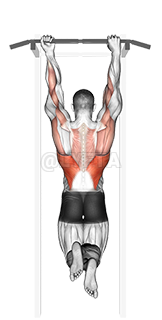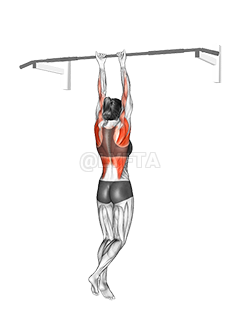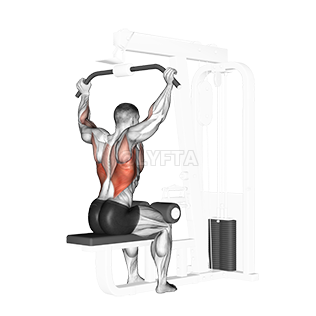
Pull up
Exercise Profile
Related Exercises:
Introduction to the Pull up
Pull-ups are a highly effective upper body exercise that primarily target the muscles in your back, shoulders, and arms, while also engaging your core. They are suitable for anyone looking to increase their upper body strength, improve muscle definition, or enhance their overall fitness level. By incorporating pull-ups into your workout routine, you can boost your functional strength, improve your physical performance, and even enhance your posture and body alignment.
Performing the: A Step-by-Step Tutorial Pull up
- Pull your body up by squeezing your shoulder blades together while keeping your elbows close to your body until your chin is over the bar.
- Ensure that your core is engaged and your body is not swinging back and forth during the movement.
- Hold the position at the top for a moment, then slowly lower your body back down to the starting position.
- Repeat the exercise for your desired number of sets and repetitions.
Tips for Performing Pull up
- **Engage Your Core**: To perform a pull-up effectively, you need to engage your core muscles. This helps stabilize your body and prevent unnecessary swinging. A common mistake is to focus only on the arms and back, but pull-ups are a full-body exercise and engaging your core will help you perform them more effectively.
- **Don't Rush**: It's crucial to perform pull-ups in a slow and controlled manner. This ensures that
Pull up FAQs
Can beginners do the Pull up?
Yes, beginners can do pull-up exercises, but it can be challenging as it requires significant upper body strength. Here are a few tips for beginners: 1. Start with Assisted Pull-ups: Use a resistance band or an assisted pull-up machine at a gym to help lift your body weight. 2. Negative Pull-ups: Jump or use a step to get your chin above the bar, then slowly lower yourself. 3. Inverted Rows: This exercise uses the same muscles but allows you to stay closer to the ground. 4. Strengthen your muscles: Work on strengthening your back, shoulder, and arm muscles with other exercises like dumbbell rows or bicep curls. 5. Gradual Progress: Gradually try to do more pull-ups over time. Don't rush, as it's important to maintain proper form to prevent injuries. Remember, it's always important to warm up before exercising and cool down afterwards. Consulting with a fitness professional can also be beneficial to ensure you're doing the
What are common variations of the Pull up?
- The Wide-Grip Pull-Up is a pull-up variation where your hands are placed wider than shoulder-width apart, emphasizing your back muscles more.
- The Neutral-Grip Pull-Up involves gripping the bar with your palms facing each other, which can reduce strain on your wrists and shoulders.
- The Commando Pull-Up is a variation where you grip the bar with both hands facing opposite directions and pull your head up to either side of the bar, targeting different muscle groups.
- The L-Sit Pull-Up is a pull-up variation where you hold your legs parallel to the ground in a seated position while pulling up, which engages your core as well as your upper body.
What are good complementing exercises for the Pull up?
- Push-ups complement pull-ups by working the opposing muscle groups; while pull-ups primarily target your back and biceps, push-ups work your chest, shoulders, and triceps, thereby ensuring a balanced upper-body workout.
- Lat pulldowns are similar to pull-ups in that they target the same muscles - the latissimus dorsi or 'lats' - but can be performed at a lighter weight, helping to build strength and endurance in these muscles, and thus improving your pull-up performance.
Related keywords for Pull up
- Bodyweight back exercise
- Pull up workout
- Home workout for back
- Strength training exercises
- Upper body workouts
- Back muscle exercises
- No-equipment back workout
- Fitness routine with pull ups
- Strength training with body weight
- Bodyweight exercise for back muscles









